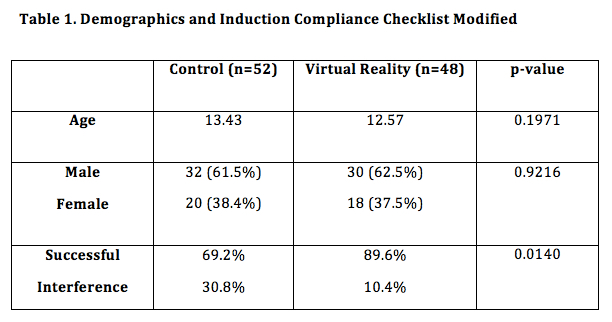OS1-129
Immersive Virtual Reality (VR) improves compliance during a minor procedure
Tsui J, Caruso T, Rodriguez S
Stanford University, Palo Alto, California, USA
Background
Virtual reality (VR) replaces visual and auditory stimuli with a virtual experience chosen by the user.1 This cognitive behavioral intervention can divert attention from a stressful stimulus such as needle insertion to an enjoyable experience.2 Using a modified Samsung Gear VR headset, a commercially available game immerses children into an aquatic safari park, which is age appropriate and user friendly without requiring active participation from the child.
Objective
This study examined the effectiveness of using immersive VR in reducing stress during a minor procedure (intravenous puncture, intravenous catheter insertion or subcutaneous venous port access).
Methods
Children ages 7 to 18 were recruited. They were randomized to an intervention (VR) group or non-intervention (control) group. An observer recorded signs of distress through a modified version of the Induction Compliance Checklist (ICC)3 tailored to all procedure compliance. The entire procedure was video recorded. The success endpoint of “perfect access†was defined as complete cooperation without any signs of distress noted in the ICC criteria. Various pre and post surveys of the procedures were also obtained.
Results
A total of 112 subjects were recruited and 12 subjects were excluded (incomplete data and technical problems) from the analysis. There were no significant differences between the groups in their demographics or their pre and post surveys. The VR group (10.4%) had a significantly lower (p=0.01) incidence of children with signs of distress than the control group (30.8%) during the procedure.
Conclusion
The immersive VR reduced the incidence percentage of children with signs of distress during a needle related procedure.
References
1. Ram D, Shapira J, Holan G, Magora F, Cohen S, Davidovich E. Audiovisual video eyeglass distraction during dental treatment in children. Quintessence Int [Internet] 2010 [cited 2017 May 26];41(8):673–9. Available from: http://www.ncbi.nlm.nih.gov/pubmed/20657857
2. Li A, Montaño Z, Chen VJ, Gold JI. Virtual reality and pain management: current trends and future directions. Pain Manag [Internet] 2011 [cited 2017 Jun 15];1(2):147–57. Available from: http://www.ncbi.nlm.nih.gov/pubmed/21779307
3. Kain ZN, Mayes LC, Wang SM, Caramico LA, Hofstadter MB. Parental presence during induction of anesthesia versus sedative premedication: which intervention is more effective? Anesthesiology [Internet] 1998 [cited 2017 May 26];89(5):1147–56; discussion 9A–10A. Available from: http://www.ncbi.nlm.nih.gov/pubmed/9822003
Top












